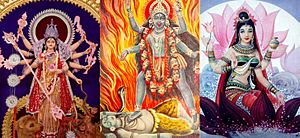Shakti facts for kids
Shakti (Devanagari: शक्ति, IAST: Śakti; lit. "Energy, ability, strength, effort, power, capability") is the primordial cosmic energy and represents the dynamic forces that are thought to move through the entire universe in Hinduism, and especially Shaktism, a major tradition of Hinduism. Shakti is the personification of the energy that is creative, sustaining, as well as destructive, sometimes referred to as auspicious source energy.
As the Shakti or Creatrix, She is known as "Adi Shakti" or "Adi Para Shakti" (i.e., Primordial Inconceivable Energy). On every plane of creation, energy manifests itself in all forms of matter, thermal energy, potential energy, gravitational energy etc. These are all thought to be infinite forms of the Para Shakti. But Her true form is unknown, and beyond human understanding. She is Anaadi (with no beginning, no ending) and Nitya (forever).
In Shaktism, Adi Parashakti is worshipped as the Supreme Being.
Origin
Found in a Paleolithic context in the Son River valley and dating to 9,000–8,000 BCE, the Baghor stone, says Jonathan Mark Kenoyer, is highly probable that the stone is associated with Shakti. The worshipping of Shiv and Shakti was also prevalent in Indus valley civilization.
Evolution
The Shakti goddess is also known as Amma in south India, especially in the states of Karnataka, Tamil Nadu, Kerala, Telangana, and Andhra Pradesh. There are many temples devoted to various incarnations of the Shakti goddess in most of the villages in South India. The rural people believe that Shakti is the protector of the village, the punisher of evil people, the cure of diseases, and the one who gives welfare to the village. They celebrate Shakti Jataras with great interest once a year. Some examples of Shakti names are Mahalakshmi, Kamakshi, Parvati, Lalita, Bhuvaneshwari, Durga, Meenakshi, Mariamman, Yellamma, Poleramma, and Perantalamma.
Shaktisim
Sri Guru Amritananda Nath Saraswati, performing the Navavarana Puja, an important ritual in Srividya Tantric Shaktism, at the Sahasrakshi Meru Temple at Devipuram, Andhra Pradesh, India.
Shaktism regards Devi (lit., "the Goddess") as the Supreme Brahman itself with all other forms of divinity considered to be merely Her diverse manifestations. In the details of its philosophy and practice, Shaktism resembles Shaivism. However, Shaktas (Sanskrit: शक्त, Śakta, ), practitioners of Shaktism, focus most or all worship on Shakti, as the dynamic feminine aspect of the Supreme Divine. Shiva, the masculine aspect of divinity, is considered solely transcendent, and Shiva's worship is usually secondary.
Shakti Peeths
Main article: Shakti Peetha
According to some schools, there are four Adi Shakti Pitha and 51 Shakti centers of worship located in South Asia (four Adi Shakti Pitha are also part of 51 Shakti pithas but they are four major parts of Devi Sati's body. So, they are adi shakti pithas). They can be found in India, Sri Lanka, Nepal, Bangladesh, Tibet and Pakistan. These are called Shakti Peethas. The list of locations varies. A commonly accepted list of Shakti Peethas and their temple complexes includes:
- Hinglaj Mataji Balochistan
- Tara Tarini (Brahmapur, Odisha)
- Katyayani (Chattarpur, Delhi)
- Bhadrakali (Kodungallur, Kerala)
- Kamakhya (Assam)
- Kali at Kalighat (Kolkata, West Bengal)
- Guhyeshwari Temple Devi (Kathmandu, Nepal)
- Ambaji (Gujarat)
- Vishalakshi Temple (Varanasi)
- Chandranath Temple (Sitakunda, Bangladesh)
- Jwalaji (Himachal)
- Naina Devi Temple (Uttarakhand)
- Mangala Gauri (Bihar)
Other pithas in Maharashtra are:
- Tuljapur (Jagdamba)
- Kolhapur (Mahalaxmi)
- vani-Nashik (Saptashrungi)
- Mahurgadh (Renukamata)
Bhajans and mantras
There are many ancient Shakti devotional songs and vibrational chants in the Hindu and Sikh traditions (found in Sarbloh Granth). The recitation of the Sanskrit mantras is commonly used to call upon the Divine Mother.
- Adi Shakti, Adi Shakti, Adi Shakti, Namo Namo!
- Sarab Shakti, Sarab Shakti, Sarab Shakti, Namo Namo!
- Prithum Bhagvati, Prithum Bhagvati, Prithum Bhagvati, Namo Namo!
- Kundalini Mata Shakti, Mata Shakti, Namo Namo!
- Primal Shakti, I bow to Thee!
- All-Encompassing Shakti, I bow to Thee!
- That through which Divine Creates, I bow to Thee!
- Creative Power of the Kundalini, Mother of all Mother Power, To Thee I Bow!
-
- — Yogi Bhajan
-
"Merge in the Maha Shakti. This is enough to take away your misfortune. This will carve out of you a woman. Woman needs her own Shakti, not anybody else will do it ... When a woman chants the Kundalini Bhakti mantra, God clears the way. This is not a religion, it is a reality. Woman is not born to suffer, and woman needs her own power."
- ~ Yogi Bhajan (Harbhajan Singh)
Images for kids
-
Sri Guru Amritananda Nath Saraswati, performing the Navavarana Puja, an important ritual in Srividya Tantric Shaktism, at the Sahasrakshi Meru Temple at Devipuram, Andhra Pradesh, India.
See also
 In Spanish: Sakti para niños
In Spanish: Sakti para niños



